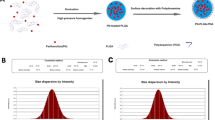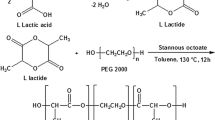Abstract
Background
Gastric cancer is the world’s fifth most prevalent cancer and its treatments are associated with issues. In this investigation, a UIO-66 nanoparticle was loaded with Gingerol (UIO-66-Gin) as a great drug carrier vehicle for chemotherapy of the AGS cancer cell lines.
Methods and Results
UIO-66-Gin characterization was performed using SEM, DLS and FTIR tests. The release profile of Gin from UIO-66 was also assessed. The cytotoxicity of UIO-66-Gin against AGS cells was assessed using MTT assay. Caspase3, Caspase9, Bax, and Bcl2 genes expression was evaluated via Real-time PCR and apoptosis rate was performed using flow-cytometry assay. Size analysis indicated the spherical shape of nano-formulation with the mean size of 174.3 nm. Release analysis indicated that there was a 50% Gin release from the nanocarrier was reported in roughly 21 h, which revealed the regulated release of bioactive compound from the UIO-66 formulation in PBS medium. After 48 and 72 h, various concentration of both the Gin and UIO-66-Gin started to induce cytotoxicity in cancerous cells. However, the induction of cytotoxicity was higher in cells treated with UIO-66-Gin. UIO-66-Gin could induce the expression of pro-apoptotic (Bax, Caspase3, and Caspase9) genes and down-regulate the expression of Bcl2 as anti-apoptotic gene rather than other formulation. Flowcytometry results indicated that the elevation of apoptotic rate in cells treated with UIO-66-Gin was significantly higher than Gin treated cells.
Conclusions
Our investigation revealed the potent anticancer effect and apoptotic induction ability of UIO-66-Gin against cancerous cells through altering the expression of genes involved in apoptosis.




Similar content being viewed by others
Abbreviations
- Bax :
-
Bcl2 Associated X
- Bcl2 :
-
B-cell lymphoma 2
- AKT :
-
serine/threonine-specific protein kinase
- DLS:
-
Dynamic Light Scattering
- SEM:
-
Scanning Electron Microscope
- FTIR:
-
Fourier transform infrared
- FITC:
-
Fluorescein isothiocyanate
- PS:
-
phytosiderophores
- ZIF-8:
-
Zeolitic imidazolate framework-8
- UIO-66:
-
Zirconium 1,4-dicarboxybenzene MOF
References
Hamashima C (2020) The burden of gastric cancer. Annals of translational medicine 8
Tan MC, Graham DY (2019) Gastric cancer risk stratification and surveillance after Helicobacter pylori eradication: 2020. Gastrointest Endosc 90:457–460
Machlowska J, Baj J, Sitarz M, Maciejewski R, Sitarz R (2020) Gastric cancer: epidemiology, risk factors, classification, genomic characteristics and treatment strategies. Int J Mol Sci 21:4012
Yang L, Ying X, Liu S et al (2020) Gastric cancer: Epidemiology, risk factors and prevention strategies. Chin J Cancer Res 32:695
Mashhadi NS, Ghiasvand R, Askari G, Hariri M, Darvishi L, Mofid MR (2013) Anti-oxidative and anti-inflammatory effects of ginger in health and physical activity: review of current evidence. Int J Prev Med 4:S36
Wang X, Shen Y, Thakur K et al (2020) Antibacterial activity and mechanism of ginger essential oil against Escherichia coli and Staphylococcus aureus. Molecules 25:3955
Osaro-Matthew R, Ire F, Frank-Peterside N (2020) Screening of actinomycetes from turmeric (Curcuma longa L.) and ginger (Zingiber officinale) rhizosphere for antifungal activity. J Adv Microbiol 20:18–28
Ahmed SHH, Gonda T, Hunyadi A (2021) Medicinal chemistry inspired by ginger: exploring the chemical space around 6-gingerol. RSC Adv 11:26687–26699
Xu S, Zhang H, Liu T et al (2020) 6-Gingerol induces cell-cycle G1-phase arrest through AKT–GSK 3β–cyclin D1 pathway in renal-cell carcinoma. Cancer Chemother Pharmacol 85:379–390
Chatupheeraphat C, Nantasenamat C, Deesrisak K, Roytrakul S, Anurathapan U, Tanyong D (2020) Bioinformatics and experimental studies of anti-leukemic activity from 6-gingerol demonstrate its role in p53 mediated apoptosis pathway. EXCLI J 19:582
Karatay KB, Kılçar AY, Derviş E, Müftüler FZB (2020) Radioiodinated ginger compounds (6-gingerol and 6-shogaol) and incorporation assays on breast cancer cells. Anti-Cancer Agents in Medicinal Chemistry (Formerly Current Medicinal Chemistry-Anti-Cancer Agents). 20:1129–1139
Manatunga DC, de Silva RM, de Silva K, Wijeratne DT, Malavige GN, Williams G (2018) Fabrication of 6-gingerol, doxorubicin and alginate hydroxyapatite into a bio-compatible formulation: enhanced anti-proliferative effect on breast and liver cancer cells. Chem Cent J 12:1–13
Cao J, Li X, Tian H (2020) Metal-organic framework (MOF)-based drug delivery. Curr Med Chem 27:5949–5969
Ge X, Wong R, Anisa A, Ma S (2021) Recent development of metal-organic framework nanocomposites for biomedical applications.Biomaterials,121322
Hoop M, Walde CF, Riccò R et al (2018) Biocompatibility characteristics of the metal organic framework ZIF-8 for therapeutical applications. Appl Mater Today 11:13–21
Celeste A, Paolone A, Itié J-P et al (2020) Mesoporous metal–organic framework MIL-101 at high pressure. J Am Chem Soc 142:15012–15019
Liu X (2020) Metal-organic framework UiO-66 membranes. Front Chem Sci Eng 14:216–232
Pirzadeh K, Esfandiari K, Ghoreyshi AA, Rahimnejad M (2020) CO2 and N2 adsorption and separation using aminated UiO-66 and Cu3 (BTC) 2: A comparative study. Korean J Chem Eng 37:513–524
Chowdhuri AR, Laha D, Chandra S, Karmakar P, Sahu SK (2017) Synthesis of multifunctional upconversion NMOFs for targeted antitumor drug delivery and imaging in triple negative breast cancer cells. Chem Eng J 319:200–211
Rakhshani N, Hassanzadeh Nemati N, Ramezani Saadat Abadi A, Sadrnezhaad S (2021) Fabrication and evaluation of controlled release of Doxorubicin loaded UiO-66-NH2 metal organic frameworks.International Journal of Engineering34
Tulig K, Walton KS (2014) An alternative UiO-66 synthesis for HCl-sensitive nanoparticle encapsulation. RSC Adv 4:51080–51083
Akbarzadeh I, Shayan M, Bourbour M et al (2021) Preparation, optimization and in-vitro evaluation of curcumin-loaded niosome@ calcium alginate nanocarrier as a new approach for breast cancer treatment. Biology 10:173
Dabbagh Moghaddam F, Akbarzadeh I, Marzbankia E et al (2021) Delivery of melittin-loaded niosomes for breast cancer treatment: an in vitro and in vivo evaluation of anti-cancer effect. Cancer Nanotechnol 12:1–35
Nafees S, Zafaryab M, Mehdi SH, Zia B, Rizvi MA, Khan MA (2021) Anti-cancer effect of gingerol in cancer prevention and treatment. Anti-Cancer Agents in Medicinal Chemistry (Formerly Current Medicinal Chemistry-Anti-Cancer Agents). 21:428–432
Furlan V, Bren U (2020) Protective effects of [6]-gingerol against chemical carcinogens: mechanistic insights. Int J Mol Sci 21:695
Suresh K, Matzger AJ (2019) Enhanced drug delivery by dissolution of amorphous drug encapsulated in a water unstable metal–organic framework (MOF). Angew Chem Int Ed 58:16790–16794
Nasrabadi M, Ghasemzadeh MA, Monfared MRZ (2019) The preparation and characterization of UiO-66 metal–organic frameworks for the delivery of the drug ciprofloxacin and an evaluation of their antibacterial activities. New J Chem 43:16033–16040
Markopoulou P, Panagiotou N, Li A et al (2020) Identifying differing intracellular cargo release mechanisms by monitoring in vitro drug delivery from MOFs in real time. Cell Rep Phys Sci 1:100254
McIlwain DR, Berger T, Mak TW (2013) Caspase functions in cell death and disease. Cold Spring Harb Perspect Biol 5:a008656
Campbell KJ, Tait SW (2018) Targeting BCL-2 regulated apoptosis in cancer. Open biology 8:180002
Sp N, Kang DY, Lee J-M, Bae SW, Jang K-J (2021) Potential antitumor effects of 6-gingerol in p53-dependent mitochondrial apoptosis and inhibition of tumor sphere formation in breast cancer cells. Int J Mol Sci 22:4660
Martin ACB, Fuzer AM, Becceneri AB et al (2017) [10]-gingerol induces apoptosis and inhibits metastatic dissemination of triple negative breast cancer in vivo. Oncotarget 8:72260
Zhang L, Lei J, Ma F, Ling P, Liu J, Ju H (2015) A porphyrin photosensitized metal–organic framework for cancer cell apoptosis and caspase responsive theranostics. Chem Commun 51:10831–10834
Mohammed MS (2021) The Molecular Activity of Gingerol on Inhibits Proliferation of Breast Cancer Cell Line (MCF7) Through Caspase Activity. Annals of the Romanian Society for Cell Biology, pp 11095–11103
Justus CR, Dong L, Yang LV (2013) Acidic tumor microenvironment and pH-sensing G protein-coupled receptors. Front Physiol 4:354
Li L, Ji Y, Ma Y-X, Gao L-Q, Zhou H-G, Wu M-H (2019) 6-Gingerol inhibits proliferation in gastric cancer via the STAT3 pathway in vitro. Cellular and Molecular Biology. France) 65:109–113(Noisy-le-Grand
Hu SM, Yao XH, Hao YH, Pan AH, Zhou XW (2020) 8–Gingerol regulates colorectal cancer cell proliferation and migration through the EGFR/STAT/ERK pathway. Int J Oncol 56:390–397
Funding
The authors declare that no funds, grants, or other support were received during the preparation of this manuscript.
Author information
Authors and Affiliations
Contributions
All authors contributed to the study conception and design. Material preparation, data collection and analysis were performed by Irana Kazazi, Fatemeh Ashrafi and Maryam Malekloo. The first draft of the manuscript was written by Irana Kazazi and all authors commented on previous versions of the manuscript. All authors read and approved the final manuscript.
Corresponding author
Ethics declarations
Competing Interests
The authors have no relevant financial or non-financial interests to disclose.
Conflict of interest
Authors declare that they have no conflict of interest.
Ethical approval
This article does not contain any studies with human participants or animals performed by any of the authors.
Additional information
Publisher’s Note
Springer Nature remains neutral with regard to jurisdictional claims in published maps and institutional affiliations.
Rights and permissions
Springer Nature or its licensor holds exclusive rights to this article under a publishing agreement with the author(s) or other rightsholder(s); author self-archiving of the accepted manuscript version of this article is solely governed by the terms of such publishing agreement and applicable law.
About this article
Cite this article
Kazazi, I., Ashrafi, F. & Malekloo, M. Synthesis of Gingerol-loaded Uio-66 nanoparticles and its anti-cancer effect against gastric cancer cell line (AGS). Mol Biol Rep 50, 3503–3513 (2023). https://doi.org/10.1007/s11033-022-07667-9
Received:
Revised:
Accepted:
Published:
Issue Date:
DOI: https://doi.org/10.1007/s11033-022-07667-9




